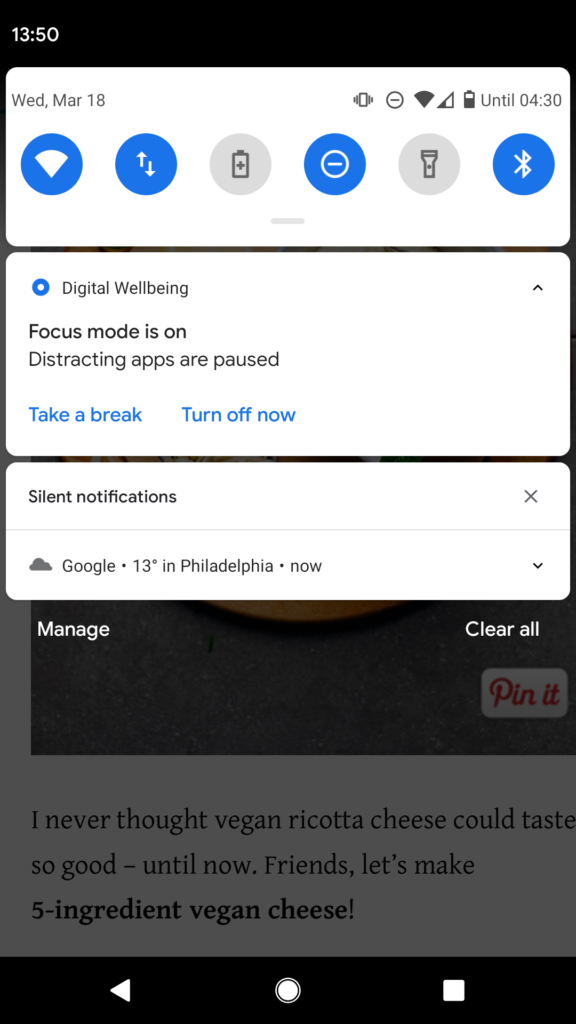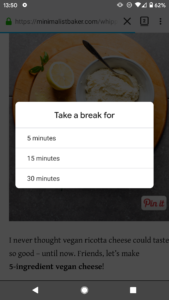So, we’re living in some interesting times, eh? I recently discovered my new favorite group of settings on my phone, Digital Wellbeing, and it made me think that maybe a list of the things I use in my anxiety-management toolkit might be useful for other folks.
Aside from my newfound passion for phone settings, the things on this list are or can be completely analog, and I’ve been employing some of them for nearly 15 years.
Digital Wellbeing
Over the weekend, I was getting messages from friends, checking social media, and I remembered: there has to be a setting to control this/stop me from doing this, and yes, there is! “Focus Time” allows you to mute distracting apps (without turning off all data, a la airplane mode). So I mute texts (Signal, WhatsApp, SMS, KeyBase …) and Instagram (which has DMs) via this feature, and I just …. leave it on.

When I want to “take a break”, there are time-boxed options, and when time is up, things just go away. It’s soooooo nice.

Now onto the non-tech tools:
Building Blocks – Breathing
A baseline skill to work on and develop is breathing exercises. Box breathing (breathe in for 3-5 seconds, hold for 3-5 seconds, breathe out for 3-5 seconds, hold out for 3-5 seconds, and repeat, so it makes a “box” type pattern) is one of the first strategies I learned. Breathing exercises, practiced when you’re not panicking, are in your toolkit to grab for when you are. But starting whenever you can is helpful.
If breathing exercises end up interesting you, there is absolutely a total nerd hole you can fall into — in yoga practices, “pranayama” is what you’ll want to look for. Kundalini yoga, as a school of yoga, puts a lot of emphasis on breath work.
Some of my favorite breathing exercises:
- Alternate nostril breathing (nadi shodhana)
- Breath of fire (note, this is an energizing practice, and there are many counter-indications for it, so read those before you try)
- Belly breathing (lay on your back, breathe such that you feel your belly go up and down)
- A great big sigh (not a breathing exercise per se, but “I’m going to take a deep breath now”, as in, fill my lungs to the capacity they feel at that moment, and let it out slow-ish, is a pretty handy and portable thing)
Internal and External Processing
This is essentially journaling vs. talking to people. I love my friends and appreciate them, and talking to other people about things can be a really important step. But so is talking to myself (internal processing), and I do that through journaling, principally. I don’t always have a daily journaling practice, but I try and journal a couple times a month in a for-posterity way.
When I journal daily, I’m using the morning pages technique I learned from The Artist’s Way. The Artist’s Way is a 12-week program for rediscovering/sparking your creativity, and I essentially view it as 12 weeks of very cheap therapy where you emphasize self-care.
I’ve used the program partially a few times, and did it from start to end in 2018, as a burnout recovery technique (I still had more burnout to do though, and recovery continued in 2019).
Since I apparently haven’t written about it here on the blog as yet, morning pages (in my view and how I use them) are three pages of free writing, ideally done in the morning (but there are no rules, yo), and you do not read your pages. No. Banned. Bad. I throw my morning pages journals in the trash (and met an older journalist a few years ago who recommended this as well). If I lived a more permacultural lifestyle, I would recycle the pages into fresh paper, but I’m not there yet.
I don’t read my pages because my morning pages are mind-junk. Anything I want to take (“oh, I should write a blog post about my anxiety toolkit” for example, as something that came up while journaling) I make a note of elsewhere. The Artist’s Way is a beautiful book and Julia Cameron writes in such a lovely way about why you don’t read your morning pages. Quick caveat: if you do TAW program, there are times when you review your pages to highlight things, but in using this practice outside of the program, I rarely read my pages.
Now onto talking to people. Talking to friends, or talking to strangers, is an essential tool. Friends, because we’ve built trust with them. But connecting with strangers — have you had the experience where you just Share a Big Thing with someone you barely know (that’s one reason why there’re jokes about this around first dates)?
Where do I find strangers? Casual social contact (“Hello!” on the street, or a short conversation with someone on the street) is one when I’m out and about. Online, it looks like using some of the closed online communities I’m a part of — I won’t name check them here, but any of the closed communities I’m in have some commonality that people there have agreed to be there for a common purpose, but I don’t necessarily know them all. Thus I can share “here’s what’s going on with me” (ex. “I like like this person, what do I do??” in a group talking about dating) without the concerns of having told a friend I regularly see IRL, who then needs to “keep a secret” for me, or might be tempted to help, when I just want to talk. I also talk to friends who live in other states/other countries by voice on a fairly regular basis. Sometimes, our distance is what allows us to be really close, and when we do get to see each other in person, it makes it all the more treasured.
And of course, duh, therapy is great, but I hold a personal opinion that if we expect “go to therapy” to be the answer for anyone with any level of “I have feelings and it would be helpful to talk about them” there are so many people who aren’t being heard. We as a community carry the load together.
The New York Times recently had some articles around listening, including how we’re more likely to tune out the people close to us (ouch). I guess this means some of my anxiety toolkit is also developing strong listening skills, because it’s like friendship: want good friends, be a good friend. Want to be heard, be a good listener. It’s such a fantastic and powerful skill to develop.
Fitness & Creative Practices
I believe that energy has to go somewhere, and anxiety is a build-up of energy. I recently read the Burnout book, and I feel like that was something she was saying. This energy builds up, and it needs to go somewhere. The top candidate, if you can, is fitness/movement. That’s not available to everyone though, and creative practices work as an outlet as well (write, draw, make music, make something).
Movement [which I’ll now use in the place of the word fitness in this section] allows energy to move through the body. When it doesn’t, I feel stuck. My feelings and my body are in an intimate relationship with each other, and moving things through my body can often help if I can’t move them through my mind.
I also just really love movement. I think of past-me as a couch potato, but looking at it again, I started doing yoga from a $0.50 library-sale-book when I was 13 (or 14, can’t remember) in my living room. I really embraced the idea of me being an athletic type once I started riding bicycles. A friend of mine once said he saw me riding around the city on my bike, and I just looked so happy. Moving makes me happy. I love biking, I love dance, I love picking up heavy things and putting them down (ok that sounds like a weird turn maybe, but lifting weights feels really really badass).
As much as I love this though, and sometimes I do train for hours a day, it’s not always practical or possible (bodies!). So I maintain other things (such as making electronic music with programming) as other outlets I can dip into. Because while I would actually love to workout for hours, it’s … not the wisest idea for staying injury-free (and can lead to eating disorders). Writing on this blog, for example, I consider a creative outlet.
Meditation
I learned about meditation when I first started dabbling in yoga, when I was about 13 or 14. But before that, I knew about prayer from growing up going to church. It wasn’t until I did my yoga teacher training 10 years ago, where having a daily meditation practice was part of the course, that I started to develop a habit that would stick (which then led to me ditching my yoga obsession, because I felt meditation was the star … oops).
I’ve described meditation in the past as “CrossFit for my brain” — when I go too long without sitting [meditation], I notice my brain getting out of shape. There’s a reason it’s called a “meditation practice” — because when I sit, I’m practicing for using that mindset ideally all of the time, because what I practice (personally) is existing in the present moment.
There are many many MANY kinds of meditation, and IMHO, prayer is under-counted as a form of meditation. I’ve tried a handful of styles of meditation: metta (loving kindness), vipassana, breath meditation, guided meditations including yoga nidra, bhakti yoga/mantra meditation (Hare Krishna), generally Kundalini yoga, and a few schools of Zen, including Kwan Um and Mountain & Rivers Order.
This is kinda good news/bad news in my opinion … if you think meditation is one thing and it just doesn’t work for you, uh, good news/bad news, it’s not!! And even within the style I currently prefer (Zen), there are scores of different schools and approaches.
Currently, I practice Zen meditation, ideally every day. I’m not strict about every day (although it’s my goal for most of the time, and I feel off-kilter if I stray too far), because I feel being attached to practicing every day is its own form of attachment 🙂 Which, learning about attachment and illusion is part of my practice, and trying to just … Be.
A short list of a couple Buddhist books that I’ve enjoyed:
- Dropping Ashes on the Buddha (Kwan Um school related, I used to sit with an affiliated group)
- Zen Heart
- A Path With Heart
- [edit addition in 2021] Love and Rage
What I’m Using Currently
After sharing all that, I feel like making it clear that I don’t do all of this all of the time!! I use some on a daily (or ideally daily) basis, and some I only dip into on occasion, for a refresher or a nice recharge.
My current daily practice is ideally: morning pages, followed by meditation (emptier mind after pages). Fitness at some point during the day.
Other stuff is negotiable, or comes as it’s useful (doing a Buddhist reading, monthly or bi-weekly journaling in my long-term/save for posterity journal), and talking to other people is at least an every other day. Creative stuff … I ought to be doing that daily, but that’s not currently true. It would be nice though.